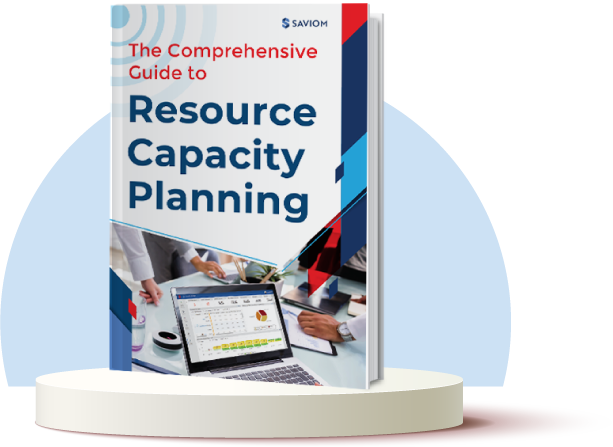Even today, many organizations continue to perform resource capacity planning processes using legacy systems.
The Excel spreadsheets and half-baked home-grown solutions are incredibly limiting, time-consuming, and lack real-time updates. In fact, “88% of spreadsheets are difficult to maintain and are not equipped to meet new business challenges.”
Since these outdated systems lack the mechanisms required to efficiently forecast, deploy, and manage workforce requirements, businesses are in desperate need of enterprise-level resource capacity planning tools and strategies.
This guide has been designed for businesses to understand the significance of resource capacity planning in project management and how it can help them future-proof their workforce.
But before delving into the details, let’s first understand the capacity planning definition.
What is Resource Capacity Planning?
Resource capacity planning predicts the gap between future project demand and workforce capacity to identify the shortfall or excesses of resources. Based on the analysis, one can develop a resource capacity plan to bridge the gap proactively for successful project delivery while ensuring every resource is optimally utilized.
Therefore, it is an essential step before resource allocation that ensures all necessary resources are available before the project’s onset. At the same, it helps organizations to take measures to minimize capacity wastage and, in turn, billable losses.
The resource capacity planning process requires firms to centralize critical information from various systems and establish a single source of truth. They need real-time data on key metrics such as skill sets, current and pipeline project schedules, resource capacity, vacations, and non-project activities. This data helps them assess whether they are equipped to meet all their immediate and future project requirements.
Let’s understand this critical process through a resource capacity planning example.
Resource Capacity Planning Example
In an audit & accounting firm, there are 5 projects in the pipeline that have reached the probability stage. At this point, the resource managers begin the capacity planning process to understand whether they are equipped with the right talent to take on these upcoming opportunities.
Managers first gather the resource demand of these pipeline projects. This includes outlining the number of resources and their types, skillsets, expertise levels, and timeline that’s required for the complete project lifecycle. Once they have insights into the project resource requirement, managers thoroughly analyze the existing workforce capacity.
The next step involves a detailed comparison between the required resources and the available capacity to identify any skill gaps or shortages in the workforce. For instance, if Project A requires three senior auditors with expertise in financial audits and the firm only has two available, this is noted as a critical gap.
After identifying gaps, managers explore solutions to bridge these gaps. They consider options such as upskilling existing employees through targeted training programs, hiring temporary or permanent staff, or reallocating resources from other projects that are either winding down.
Furthermore, managers perform scenario analysis to anticipate different outcomes and prepare contingency plans. This might involve creating a buffer of additional freelance consultants who can be called upon if there is an unexpected increase in workload or last-minute scope changes.
By following a systematic resource capacity planning process, the audit & accounting firm can successfully manage multiple projects and ensure profitability.
Next, let’s learn about the various steps involved in the resource capacity planning process.
Resource Capacity Planning Process
A well-defined resource capacity planning process includes the following steps:
Estimate Resource Demand
The first step is to accurately forecast the resource requirements of pipeline projects. For this, managers must carefully evaluate the scope, tasks, budget, and timelines to determine the specific resources required for each project activity. In other words, it involves understanding the skill sets, types, and duration of resources needed for the entire project lifecycle.
Assess the Resource Capacity
The next step is to assess the overall resource capacity for a specified period. Managers must look into internal and external channels to calculate the cumulative workforce capacity, which includes full or part-time employees, contractors, and temporary personnel. Moreover, they must also consider planned leaves, contract terminations, or recruitment to make an accurate assessment.
Perform Capacity vs. Demand Gap Analysis
Once the project demand and workforce capacity are calculated, managers must conduct a capacity vs demand gap analysis. It helps them identify the gaps between the resources needed for future projects and the ones available within an organization. This way, managers can verify whether they have an excess or shortage of resource capacity.
Bridge the Demand Gaps
Based on the findings of the capacity analysis, managers can formulate a resource capacity plan to bridge the cap. For resource deficit, they can proactively initiate training/upskilling or staggered hiring to acquire the necessary skill sets. On the other hand, for resource surplus, they can bring forth project timelines or sell the extra capacity at discounted rates.
Read more: What is Resource Forecasting? An Ultimate Guide for Project Managers
Now that we know the various steps involved in the resource capacity planning process, let’s understand its importance.
Role of Resource Capacity Planning in Project Management
The resource capacity planning model plays a vital role in project management. Let’s learn about its role in detail:
How Does Resource Capacity Planning Help Build an Optimized Project Team?
Once a pipeline project reaches a certain probability stage, the manager estimates the resource requirements and initiates the requisition process. This allows them to identify the resource shortages or excesses ahead of time.
Accordingly, managers can apply appropriate strategies, such as hiring a permanent or contingent workforce, to ensure that the right people with the necessary skills and bandwidth are available before project commencement. Thus, it enables project managers to create an optimal project team mix of permanent/contingent or junior/senior resources based on requirements.
How Does Resource Capacity Planning Affect Utilization?
Resource capacity planning directly impacts utilization by ensuring that the right resources with the appropriate skills are available to work on the right projects and tasks. This alignment maximizes employee productivity and utilization.
Moreover, efficient capacity planning allows firms to forecast billable and strategic utilization ahead of time. Thus, it enables managers to mobilize resources from non-billable to revenue-generating tasks or projects, thereby enhancing profitable utilization.
How Does Resource Capacity Planning Impact Project Delivery?
Resource capacity planning significantly impacts project delivery by ensuring that the necessary resources, such as personnel, equipment, etc., are available and allocated throughout the project lifecycle. This helps avoid shortages or overallocation of resources, which can lead to delays, increased costs, and compromised quality.
Moreover, by aligning resources with project demands, it promotes optimal productivity, and enhances the ability to meet deadlines and deliverables. This ultimately leads to successful project outcomes.
Read More: Beat Market Volatility With Efficient Resource Capacity Planning
What are Some Resource Capacity Planning Benefits?
Resource capacity planning helps businesses plan pipeline projects and futureproof the workforce against market volatility. Here are some of the advantages of resource capacity planning for your business:
Reduces Project Resource Costs Across the Enterprise
Capacity planning strategies empower businesses to forecast skill demand accurately and arrange for the requisite personnel to arrive ahead of the curve. This approach minimizes the need for last-minute, expensive recruitment and helps reduce project resourcing costs significantly.
Moreover, it enables managers to identify the best-fit global resources from low-cost locations based on project requirements. This way, they can utilize cost-effective global resources optimally and ensure high-quality deliverables.
Read More: Reduce Resourcing Cost by 10-30% with Modern Resource Management Solution
Forecasts and Bridges the Skills Gap
Capacity planning helps identify skill shortages or excess ahead of time and take several corrective actions to eliminate them. For example, managers can:
- Readjust project start and end dates to align with the available capacity
- Hire a contingent workforce for short-term requirements
- Retrain and upskill employees to prepare them for future projects
- Bring forward some initiatives to meet strategic goals in case resources are in excess to optimize bench size
- Mobilize resources across several departments to maximize utilization and increase profitability
Ensures Competent Resource Allocation for Successful Project Execution
Having the right-skilled employees available at the right time is crucial for a project to finish within the stipulated deadline and budget. Capacity planning facilitates resource planning, which helps identify and allocate competent resources to each project based on their skills, experience, qualifications, location, resource cost rate, and other defined criteria.
This approach ensures that the “best-visible-best-fit” resource is assigned to each task rather than simply the “first-visible-first-fit.” As a result, it prevents work overload and schedule overruns, contributing to the timely completion of projects.
Read more: What is Resource Allocation? A Comprehensive Guide for Project Success
Maximizes Productive Utilization of Every Resource
Billable resource utilization is a critical KPI for businesses. Capacity planning helps balance the availability of resources with the project demand to prevent under/overallocation and minimize idle time, billing losses, work overload, etc.
Additionally, it enables to forecast billable and strategic utilization of the workforce ahead of time. Based on that, managers can mobilize employees from non-billable or low-priority work to billable or high-priority projects. This helps tap into their maximum potential and enhance profitability.
Aligns Sales and Delivery by Forecasting Pipeline Opportunities
Capacity planning helps consider the forecasted and actual deals a company wins to estimate the resources ahead of time. This process fosters coordination between the delivery and sales teams, enabling them to evaluate and assess the feasibility of sales pipeline opportunities. As a result, they gain a clear understanding of the project’s resource requirements and the client’s expectations.
By forward planning, the delivery team can ensure that the right resources are available at the right time to complete the project. This approach prevents the common issue of overcommitting and underdelivering due to sales-delivery misalignment, ensuring timely project initiation and enhancing client satisfaction.
Now that the benefits of resource capacity planning are clear, let’s move on to learn some of the best methods of resource capacity planning.
Resource Capacity Planning Best Practices that Every Manager Must Know
Resource capacity planning in project management is becoming increasingly critical for a business to reduce resourcing costs and become responsive to the market. As a result, capacity planning has gone beyond the basics of measuring workforce demand against capacity.
Here are some key strategies to implement capacity planning efficiently in your firm:
Forecast Capacity vs. Demand and Form a Project Resource Plan
A business must forecast capacity vs. demand from multiple dimensions, i.e., by role, department, team, location, skills, etc. It helps identify short- or long-term shortages/excess of resources. This enables the managers to implement the right resourcing treatments to bridge the gap.
For instance, in case of shortages, organizations can facilitate retraining/upskilling resources or hiring a permanent/contingent workforce to avoid last-minute hiring/firing costs. Conversely, when the resources are in excess, managers can either bring forward a project timeline or sell extra capacity to optimize resource utilization and ensure successful project delivery.
Read more: Project Resource Management: An Ultimate Guide on How to Master It
Track and Analyze the Competency Matrix in Real-time
Tracking and keeping up-to-date information about the workforce’s competencies and skills is critical. It allows the right resource with skill, experience, qualifications, individual preferences, etc., to be allocated to the proper work.
This also helps plan a new project that may need a niche skill that is difficult to get from the market. If such a capability is available within the organization, the resource can be out-rotated with a suitable backfill candidate. It, thus, helps initiate the new high-priority project on time without disrupting the ongoing one.
Manage Project Pipeline Efficiently
Businesses should keep track of future potential projects in the pipeline and forecast estimated resource demand. It will ensure the resource pool is optimally balanced, skilled, and ready to meet the demands of new projects.
Managers can decide whether to re-skill, hire, or have contingency resources to do the work. They can also assess the pipeline project demands to determine whether they are one-off or recurring to create an optimal mix of permanent and contingent resources and overcome budget constraints.
Read more: 4 Steps to Perfect Your Project Pipeline Management Strategy
Predict and Improve Overall Resource Utilization
Organizations should implement short- or long-term billable, strategic, and overall utilization forecasting. If resources are underutilized, managers can bring forward some project timelines or sell excess capacity to optimize their utilization.
If resources are overutilized, they can adjust projects’ timelines to match the future availability, pull in additional team members, or initiate a planned or project-specific hiring as required. This way, managers can take proactive measures to ensure optimal utilization levels of the workforce.
Foresee Project Vacancies and People on the Bench
Failure to find the right resources for the right project can cause you to lose an opportunity. Therefore, the companies should gain foresight into future resource needs and people who will end up on the bench.
It helps resource managers mix and match available people against project vacancies to avoid increased idle time and billing losses as repercussions. Not just that, robust capacity planning measures also help ensure all the projects are staffed with the right-skilled resources and ensure their successful execution.
Streamline Resource Requisition to Deliver Projects on Time
Conventionally, resource requisition and allocations are done through email or phone requests that cause chaos. The reason is that it leads to silos of information regarding resource requests and allocations across various projects. Therefore, a resource may be booked for multiple projects beyond their capacity.
It can cause not only burnout but also power conflicts among project managers for similar-skilled resources. Therefore, streamlining the process using workflow is critical to ensure resources are allocated with appropriate approvals and notifications. In addition, one must avoid unnecessary emails/telephone calls as they cannot be easily reconciled, documented, and analyzed later.
Read more: 6 Easy Steps to Request Resources Efficiently
In the following section, let’s learn how to choose the best software for your capacity planning needs.
How to Choose the Right Resource Capacity Planning Software?
Effective capacity and resource planning is essential for improving the performance of modern businesses. To move beyond the limitations of current spreadsheet functionalities, it is crucial to select a robust capacity planning software. Businesses should ensure that their chosen solution offers the following features:
The System Should be Scalable, Configurable, and Expandable
Every business is different, and so are its workforce capacity planning needs. Therefore, a business must select a scalable and configurable capacity planning software to meet current needs and expandable to meet future business requirements.
In addition, the system should be able to support and accommodate a growing user base without compromising response time and performance. Users should have the flexibility to configure the software to their specific needs and preferences independently, without relying on the vendor.
Foresight into Pipeline Demands
The software should provide multi-dimensional forecasting capabilities that gives foresight into resource demands once the project reaches the opportunity/approval sales pipeline. The software should forecast capacity vs. demand from multiple perspectives, i.e., by role, department, team, location, skills, etc. and identify short and long-term resource excess/deficits.
Based on this analysis, managers can create a comprehensive capacity plan to address and bridge the gap. Therefore, the system empowers proactive capacity planning, helping firms mitigate skill gaps and build an optimized workforce.
Critical Business Functionalities
The software should provide visibility into various attributes, including role, team, project type, location, skills, etc. It must include an in-built competency matrix that maintains and update resource skills, certifications, experience, cost rate, etc., in real-time. Additionally, the tool should have an automated workflow that allows project managers to initiate resource requests as demand arises & maintain an audit trail of all requests.
Moreover, the tool must support comprehensive resource management processes, including forecasting, capacity planning, scheduling, utilization, and optimization. This capability will streamline operations and ensure that businesses can effectively manage resources.
Manages Complex Matrix Organization Structure
Nowadays, most businesses have resources spanning different locations. Hence, they establish a matrix management structure to best utilize their resources. So, companies must have a capacity planning tool that seamlessly aligns with the complexities of a matrix organization.
The dashboard should provide a comprehensive, 360-degree view of resources, projects, and bookings across the organization. This enables managers to monitor current and future project timelines, track resource bookings, and adjust allocations in real-time.
Read more: What is Matrix Management and Why is it Important?
The Solution Must Provide Real-time BI Reports
In a dynamic business environment, project demand changes constantly, hence it is crucial to get real-time business intelligence, through reports, analytics, and dashboards. The software must offer insights into resource capacity and demand that help with capacity planning and prevent under/over-staffing.
Additionally, configurable reports and dashboards at both individual and project levels, with advanced filters, should empower managers to analyze data across multiple dimensions, such as project type, department, and team, for swift access to necessary information.
Integration Capabilities
Many businesses have already invested in enterprise-level systems that contain essential data for capacity planning, such as resource profiles, competencies, and project details. Therefore, the capacity management software must integrate seamlessly with these existing applications.
The tool should also include Excel import functionality, allowing users to easily import projects, resources, skills, timesheets, bookings, and leaves. This feature ensures smooth integration with existing workflows and systems, enhancing overall efficiency.
Modeling & Simulation Features
The tool must include modeling and simulation modules, also known as what-if analysis functionality, to explore diverse scenarios within existing constraints. This capability enables businesses to prioritize the most profitable resource plans to meet organizational goals.
The modeling and simulation feature will assist managers in building multiple scenarios in a sandbox environment and analyze their impact on the project from various angles, such as resource availability, capacity, costs, etc. This allows them to compare the outcomes of each scenario and select the best-fit resource plan.
Read more: How to Select the Best Resource Management Solution for Your Business
In this way, organizations can choose the right capacity planning solution.
Conclusion
Resource capacity planning is a crucial aspect of project resource management. By leveraging the functionalities of advanced capacity planning tools, businesses can use their resources more effectively. In addition, it also helps in reducing resourcing costs, eliminating reactive hiring, and future-proofing their workforce against market volatility.
Glossary
READ MORE : Glossary of Resource Workforce Planning, Scheduling and Management
The SAVIOM Solution
SAVIOM is the market leader in providing an enterprise resource capacity planning solution. With over 20 years of experience leading the market, Saviom is actively used by over 15 highly esteemed global companies worldwide. The tools within the suite include project portfolio management, professional service automation, and workforce planning software. Re-engineer operational efficiency with a system shaped around your business!











Leave a Reply